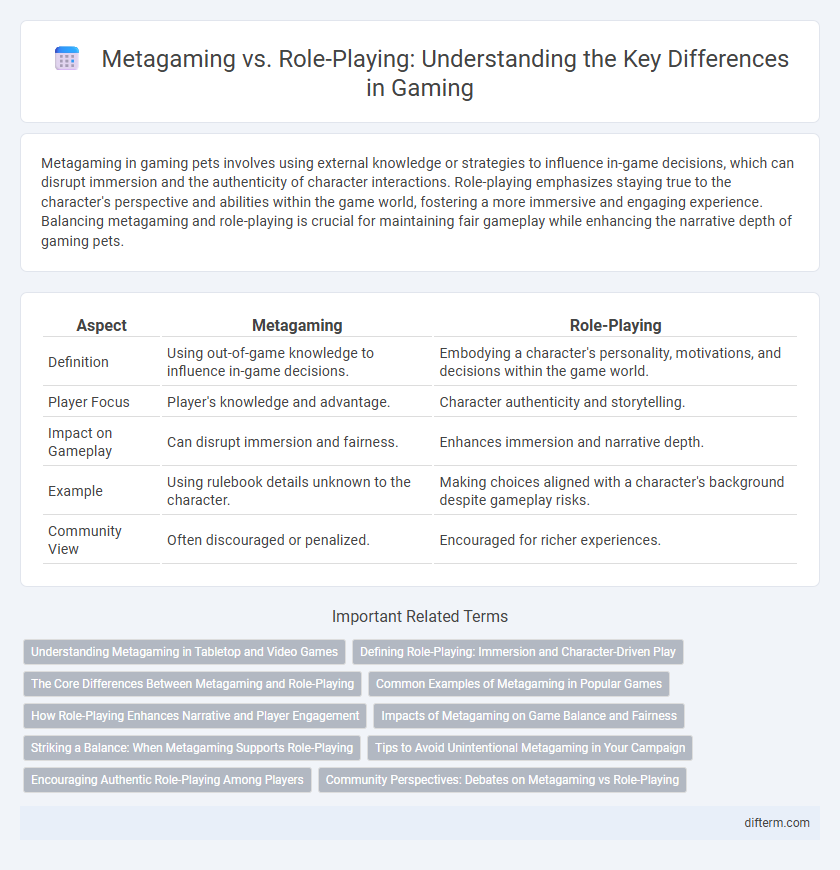Metagaming in gaming pets involves using external knowledge or strategies to influence in-game decisions, which can disrupt immersion and the authenticity of character interactions. Role-playing emphasizes staying true to the character's perspective and abilities within the game world, fostering a more immersive and engaging experience. Balancing metagaming and role-playing is crucial for maintaining fair gameplay while enhancing the narrative depth of gaming pets.
Table of Comparison
| Aspect | Metagaming | Role-Playing |
|---|---|---|
| Definition | Using out-of-game knowledge to influence in-game decisions. | Embodying a character's personality, motivations, and decisions within the game world. |
| Player Focus | Player's knowledge and advantage. | Character authenticity and storytelling. |
| Impact on Gameplay | Can disrupt immersion and fairness. | Enhances immersion and narrative depth. |
| Example | Using rulebook details unknown to the character. | Making choices aligned with a character's background despite gameplay risks. |
| Community View | Often discouraged or penalized. | Encouraged for richer experiences. |
Understanding Metagaming in Tabletop and Video Games
Metagaming in tabletop and video games involves using out-of-character knowledge to influence in-game decisions, which can disrupt immersion and challenge fairness. This contrasts with role-playing, where players make choices based solely on their character's perspective and in-world information, preserving narrative integrity. Recognizing the boundaries between metagaming and role-playing is essential for maintaining balanced gameplay and fostering authentic storytelling experiences.
Defining Role-Playing: Immersion and Character-Driven Play
Role-playing centers on deep immersion and character-driven play, encouraging players to fully embody their characters' personalities, motivations, and decisions within the game world. This approach enhances narrative engagement by prioritizing story coherence and emotional investment over strategic advantage. Role-playing fosters a dynamic, interactive experience where player choices reflect authentic character development rather than exploiting game mechanics.
The Core Differences Between Metagaming and Role-Playing
Metagaming involves using out-of-character knowledge to influence in-game decisions, often disrupting immersion and fairness. Role-playing prioritizes character-driven actions based solely on the character's knowledge, motivations, and narrative context. The core difference lies in maintaining the integrity of the game world by separating player knowledge from character knowledge.
Common Examples of Metagaming in Popular Games
Common examples of metagaming in popular games include using out-of-character knowledge to make in-game decisions, such as exploiting hidden map information in games like Among Us or leveraging strategy guides in competitive titles like League of Legends. Players might also share private character stats or plan moves based on knowledge not available within the game world, breaking immersion in role-playing games like Dungeons & Dragons. These behaviors can disrupt the narrative flow and diminish the authentic role-playing experience by prioritizing winning over character integrity.
How Role-Playing Enhances Narrative and Player Engagement
Role-playing deepens narrative immersion by allowing players to embody characters with distinct personalities, motivations, and backstories, creating more meaningful and dynamic interactions within the game world. This approach fosters emotional investment and complex storytelling, encouraging players to make decisions that align with their character's identity rather than solely optimizing for game mechanics. Enhanced player engagement results from this holistic experience, as role-playing prioritizes creative expression and collaborative world-building over competitive success characteristic of metagaming strategies.
Impacts of Metagaming on Game Balance and Fairness
Metagaming disrupts game balance by allowing players to exploit external knowledge, giving them unfair advantages over others who rely solely on in-character information. This undermines fairness, as decisions are influenced by out-of-game insights rather than role-playing authenticity, skewing the competitive environment. Maintaining strict boundaries between metagaming and role-playing is essential to preserve equitable gameplay and immersion.
Striking a Balance: When Metagaming Supports Role-Playing
Striking a balance between metagaming and role-playing enhances immersive gameplay by allowing strategic knowledge to inform character decisions without breaking narrative cohesion. Effective metagaming uses out-of-character information to enrich in-character choices, improving story development and player engagement. Maintaining this balance requires players to align their tactics with their character's personality and motivations, fostering a dynamic and believable gaming experience.
Tips to Avoid Unintentional Metagaming in Your Campaign
To avoid unintentional metagaming in your gaming campaign, encourage players to stay in character and make decisions based on their character's knowledge and experiences rather than player knowledge. Use session zero to establish clear boundaries and discuss the importance of separating player information from character awareness. Incorporate in-game consequences for actions that suggest metagaming, reinforcing immersion and maintaining role-playing integrity.
Encouraging Authentic Role-Playing Among Players
Encouraging authentic role-playing among players enhances immersion by prioritizing character development and story-driven decisions over mechanical advantages. Emphasizing narrative consistency and emotional engagement fosters deeper connections within the game world, reducing metagaming tendencies that disrupt the experience. Game masters can promote this by rewarding creativity and maintaining clear boundaries between player knowledge and character knowledge.
Community Perspectives: Debates on Metagaming vs Role-Playing
Community perspectives on metagaming versus role-playing highlight a fundamental divide between gameplay purity and narrative immersion. Role-playing emphasizes character consistency and immersive storytelling, whereas metagaming often prioritizes strategic advantage by using out-of-character knowledge. Debates frequently surface in forums and game groups, reflecting differing values on player behavior, game fairness, and the integrity of role-playing experiences.
metagaming vs role-playing Infographic

 difterm.com
difterm.com